Setúbal
| Setúbal | |||
|---|---|---|---|
| Municipality | |||
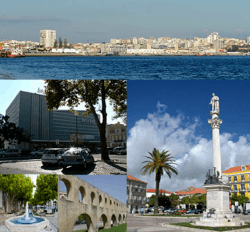 Setúbal city centre and port. | |||
| |||
 | |||
| Coordinates: 38°31′27.5″N 8°53′33.4″W / 38.524306°N 8.892611°WCoordinates: 38°31′27.5″N 8°53′33.4″W / 38.524306°N 8.892611°W | |||
| Country |
| ||
| Region | Setúbal | ||
| Subregion | Península de Setúbal | ||
| District | Setúbal | ||
| Parishes | 5 | ||
| Government | |||
| • President | Maria das Dores Meira (CDU) | ||
| Area | |||
| • Total | 230.33 km2 (88.93 sq mi) | ||
| Population (2014) | |||
| • Total | 118,166 | ||
| • Density | 510/km2 (1,300/sq mi) | ||
| Time zone | WET/WEST (UTC+0/+1) | ||
| Website | http://www.mun-setubal.pt | ||
Setúbal (Portuguese pronunciation: [sɨˈtuβal, -βɐl]; Proto-Celtic: *Caetobrix) is a city and a municipality in Portugal. The population in 2014 was 118,166,[1] in an area of 230.33 km2 (88.9 sq mi).[2] The city proper had 89,303 inhabitants in 2001.[3] Lies within Lisbon metropolitan area.
In the times of Al-Andalus the city was known as Sheṭūbar (Andalusian Arabic: شَطُوبَر [ʃeˈtˤuːbɑr]). In the 19th century, the port was called Saint Ubes in English,[4] and Saint-Yves in French.
The municipal holiday is 15 September, which marks the date in the year 1860 on which King Pedro V of Portugal officially recognised Setúbal as a city.
City information
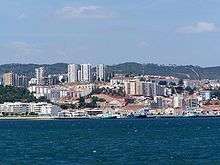
The city of Setúbal is located on the northern bank of the Sado River estuary, approximately 48 kilometres (30 miles) south of Portugal's capital, Lisbon. It is also the seat of the Setúbal District.
In the beginning of the 20th century, Setúbal was the most important center of Portugal's fishing industry, particularly sardines. None of the many factories then created are operating today. However, the existing maritime ports, either traditional, commercial and the new marines, keep the city links to the ocean and water well alive and vibrant. Tourism, based on the beautiful existing natural conditions plus excellent hotels, resorts and infrastructures, is one of the city's most appreciated resources, due to its interconnection with the Sado (river) on one side and Atlantic Ocean on another, having a coast line with both. The city is also connected with the nearby coast of the Arrábida hills natural park - which offers an unspoiled nature and beautiful beaches to the Atlantic Ocean. A dolphin colony inhabits the Sado River. Across the river on the south bank lies the peninsula of Tróia, a place with vast white/golden sand beaches where several luxury hotels and resorts were recently built. The Tróia peninsula can be sighted from the city, across the river. Albarquel, Figueirinha, Galápos, Galapinhos, Creiro and Portinho da Arrábida are some of the city's many beaches, located in the north bank of the estuary, at the very beginning of the Arrábida hills.
History
In antiquity the city was known as Cetobriga, a Turdetani settlement that came under Roman control in the province of Lusitania.
Culture
The main historical monument of the city of Setúbal is the Monastery of Jesus, with a 15th- and 16th-century church that represents one of the first buildings in the Portuguese late Gothic style known as Manueline.

Also of interest are the São Julião Church, also with Manueline portals. The Castelo de São Filipe, is a 16th- and 17th-century fortress on the north bank of the Sado river, overseeing the city. The fortress was converted into a luxury hotel (pousada).
Teatro Animação de Setúbal is based in Setúbal.
Demography (municipality)
| Year | 1801 | 1849 | 1900 | 1930 | 1960 | 1981 | 1991 | 2001 | 2011 | 2014 |
|---|---|---|---|---|---|---|---|---|---|---|
| Population | 15,442 | 15,060 | 35,990 | 50,456 | 56,344 | 98,366 | 103,634 | 113,934 | 121,061 | 118,428 |
Parishes
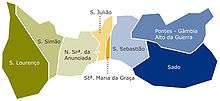
Administratively, the municipality is divided into 5 civil parishes (freguesias):[5]
- Azeitão (São Lourenço e São Simão)
- Gâmbia – Pontes – Alto da Guerra
- Sado
- São Julião, Nossa Senhora da Anunciada e Santa Maria da Graça
- São Sebastião
Climate
| Climate data for Setúbal | |||||||||||||
|---|---|---|---|---|---|---|---|---|---|---|---|---|---|
| Month | Jan | Feb | Mar | Apr | May | Jun | Jul | Aug | Sep | Oct | Nov | Dec | Year |
| Average high °C (°F) | 15.3 (59.5) |
16.7 (62.1) |
19.4 (66.9) |
20.5 (68.9) |
23.4 (74.1) |
27.4 (81.3) |
29.9 (85.8) |
30.1 (86.2) |
27.8 (82) |
23.3 (73.9) |
18.8 (65.8) |
15.9 (60.6) |
22.38 (72.28) |
| Daily mean °C (°F) | 10.1 (50.2) |
11.3 (52.3) |
13.5 (56.3) |
14.8 (58.6) |
17.4 (63.3) |
20.9 (69.6) |
23.1 (73.6) |
23.2 (73.8) |
21.3 (70.3) |
17.9 (64.2) |
13.9 (57) |
11.3 (52.3) |
16.56 (61.81) |
| Average low °C (°F) | 4.8 (40.6) |
5.8 (42.4) |
7.6 (45.7) |
9.1 (48.4) |
11.4 (52.5) |
14.3 (57.7) |
16.2 (61.2) |
16.3 (61.3) |
14.8 (58.6) |
12.4 (54.3) |
9.0 (48.2) |
6.6 (43.9) |
10.69 (51.24) |
| Average rainfall mm (inches) | 98.4 (3.874) |
75.3 (2.965) |
53.3 (2.098) |
66.7 (2.626) |
48.5 (1.909) |
16.8 (0.661) |
3.7 (0.146) |
3.7 (0.146) |
27.2 (1.071) |
97.6 (3.843) |
119.4 (4.701) |
124.7 (4.909) |
735.3 (28.949) |
| Source: Instituto de Meteorologia[6] | |||||||||||||
Economy
According to the census of 2011, the municipality of Setúbal had a labor force of 58,514 people, among whom 15.6% were unemployed. Among those who had a job, 1.6% were working in the Primary sector, 24.9% in the Secondary sector and 73.5% in the Tertiary sector.[7] Setúbal is notable for the industries of pulp, paper, cement, fertilizers, pesticides, other phytopharmaceutical products, thermal power, shipbuilding and ship repair there was a lot of automobile assembling industry since the 1950s with several known manufacturers had or have opened assembly halls for the Portuguese market. Today there are only 3 tradenames nearby currently in production. The Port of Setúbal had a cargo throughput of 6.058 million tons in 2012,[8] making it the 4th busiest port in Portugal, with 7.4% of the cargo throughput in the country.[9]
In the 19th century, the area was notable for the production of sea salt. St. Ubes bay salt was exported as far as Australia in the 1830s.[10]
Sports
The city's main sports club is Vitória de Setúbal, established on November 20, 1910.
Notable residents and citizens
- Diogo Fernandes Pereira, sometimes called simply Diogo Fernandes, was a 16th-century navigator. Diogo Fernandes was the first known European captain to visit the island of Socotra in 1503 and the discoverer of the Mascarenes archipelago ( Réunion, Mauritius, and Rodrigues) in 1507. He may also have been the first European to sail east of Madagascar island ('outer route' to the East Indies);
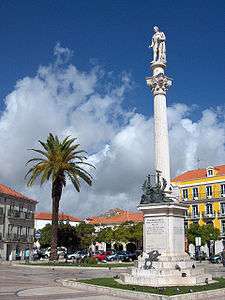
- Manuel Maria Barbosa du Bocage (1765–1805) : notable satirical and classical poet.
- Luisa Todi (1753–1833) : classical singer.
- José Mourinho : football manager.
- José Travassos Valdez, 1st Count of Bonfim (1787–1862) : soldier, politician, Prime Minister of Portugal
- Sabrina : represented Portugal at the Eurovision Song Contest 2007.
- Lima de Freitas (1927–1998) : Portuguese painter, illustrator, ceramicist and writer. He studied at the Escola Superior de Belas Artes de Lisboa. He illustrated over 100 books. Amongst his work on ceramic tiles, 14 Lisbon myths and legends tile panels are displayed at the Rossio Railway Station located at Rossio, Lisbon;
- João Vaz (1859-1931) : also a painter.
- Zeca Afonso (1929-1987) : singer and songwriter, lived and worked in the city in later life and died there.
- André Marques (filmmaker) : writer and director
- Mazgani : Luso-Iranian singer-songwriter.
- Sofia Vitória : singer.
- Luís Buchinho : fashion designer.
- Roy Campbell : poet, died nearby in a car accident.
- Matilde Lima : model and Miss Universo Portugal 2017
- Filipa Barroso : model and Miss Portuguesa 2017
International relations
Setúbal is twinned with:
|
Setúbal has international cooperation protocols with:
|
Gallery
- 16th-century fortress of St. Filipe.
- São Julião Church in central Setúbal.
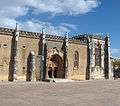 Monastery of Jesus of Setúbal (15th and 16th centuries).
Monastery of Jesus of Setúbal (15th and 16th centuries).- Cruzeiro (a Stone cross) and façade of the Monastery of Jesus of Setúbal.
 Main entrance to the Gothic-Manueline Monastery of Jesus of Setúbal.
Main entrance to the Gothic-Manueline Monastery of Jesus of Setúbal. A view of Setúbal's seaport.
A view of Setúbal's seaport.- Jardim Bonfim park.
 Largo da Misericórdia.
Largo da Misericórdia. Fortifications of Setúbal. Manesson Mallet: Travaux de Mars ou l'Art de la Guerre.
Fortifications of Setúbal. Manesson Mallet: Travaux de Mars ou l'Art de la Guerre.
References
- ↑ "Statistics Portugal". www.ine.pt. Archived from the original on 28 November 2017. Retrieved 3 May 2018.
- ↑ Direção-Geral do Território Archived 2014-09-29 at Archive.is
- ↑ UMA POPULAÇÃO QUE SE URBANIZA, Uma avaliação recente – Cidades, 2004 Archived 2014-10-06 at the Wayback Machine. Nuno Pires Soares, Instituto Geográfico Português (Geographic Institute of Portugal)
- ↑ Wedgwood, Hensleigh (1855). "On False Etymologies". Transactions of the Philological Society (6): 67.
- ↑ Diário da República. "Law no. 11-A/2013, page 552 114" (pdf) (in Portuguese). Retrieved 31 July 2014.
- ↑ "Monthly Averages for Setúbal, Portugal (1981-2010)". Instituto de Meteorologia. Archived from the original on 2013-01-11. Retrieved 2012-08-10.
- ↑ "Municípios - Emprego e Mercado de Trabalho" (in Portuguese). PORDATA Base de Dados Portugal Contemporâneo. Archived from the original on 27 August 2013. Retrieved 8 September 2013.
- ↑ "2012-Estatísticas" (in Portuguese). Porto de Setúbal - APSS, SA. Archived from the original on 4 October 2013. Retrieved 8 September 2013.
- ↑ "INE: Porto de Lisboa perdeu 30% do movimento de mercadorias" (in Portuguese). Diário Económico. Archived from the original on 5 October 2013. Retrieved 8 September 2013.
- ↑ http://nla.gov.au/nla.news-article2201134?searchTerm=Ubes
Bibliography
- See also: Bibliography of the history of Setúbal
External links
- Town Hall official website
- O Bocagiano Local News
- Setúbal na Rede is a pioneering project, innovative and the first digital-only newspaper in Portugal.


